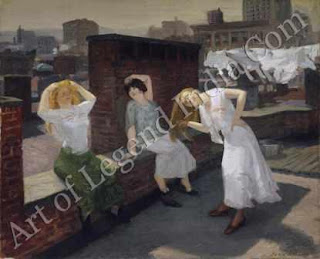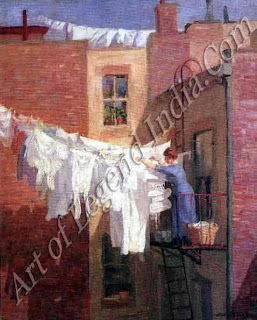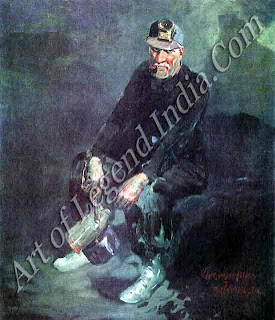American Great Artist Edward Hopper - The Ashcan School
Posted by
Art Of Legend India [dot] Com
On
2:44 AM
Labelled
as vulgar by the critics, the Ashcan school of painters was a flourishing and
original group whose inspiration was drawn from New York street scenes and the
seamier side of city life.
In the
early years of the 20th century, American painting finally emerged from the
shadow of European art and began to assert its own identity. Leading these
advances was a group of social realist painters who came to be known as the
Ashcan school.
The leader
of this influential group was the painter and teacher Robert Henri. Born Robert
Henry Cozad, Henri changed his name after his family was forced to flee
Cincinnati following his father's involvement in a shooting incident. Henri's
own work came firmly within the European orbit, his portraits bearing a close
resemblance to those of Manet. However, Henri's true importance lay in the
direction that his teaching gave to the realist movement. One commentator
described him as a 'silver-tongued Pied Piper'.
Henri
travelled to Europe on several occasions in the 1880s and 1890s. In 1888, he
was in Paris, studying under the academic painter, Adolphe Bouguereau and, in
1895, he visited Holland with William Glackens. Like Henri, Glackens' link with
the Ashcan school was tempered by his obvious fondness for European art and his
canvases reveal a particular liking for the work of Renoir.
On his
return to the States, Henri settled in Philadelphia and, from 1892-95, he
taught at the Women's School of Design. His own studio became a popular meeting
place for artists and it was during this period that the future members of the
Ashcan school first came together. Many of these artists worked initially as
illustrators on newspapers. George Luks, Everett Shinn, John Sloan and William
Glackens all began their careers this way, before Henri persuaded them to take
up painting and translate the immediacy and topicality of their journalistic
work into a vigorous new form of
American art.
Henri
preached a positive brand of liberal humanism, stressing his belief in
progress, justice and the common bonds of humanity. He called upon artists to
portray modern American life, not with the superficial prettiness that was
popular in the academies, but with the social awareness of a Goya or a Daumier.
'Be willing to paint a picture that does not look like a picture,' was his
maxim.
Towards
the end of the 19th century, the Philadelphia realist painters migrated to New
York, where the overcrowded suburbs gave an increasingly urban slant to their
pictures. Cinema audiences and street scenes in the slums were typical
subjects, while bars like McSorleys provided a virtual replica of night life in
the Latin Quarter of Paris.
In New
York, however, they also came up against the opposition of the National Academy
of Design. This imposing body had been founded in 1826 and was, in its early
days, an important sponsor of native American art. By the time that
Impressionism and Realism made their appearance, however, it had become
extremely conservative. In 1907, Luks, Glackens and Shinn were among the
artists who had their works rejected for its annual show. Henri, who was one of
the selection committee on this occasion, withdrew his own entries in protest
and set about organizing an independent exhibition.
The
result was a show by 'the Eight', which took place in February 1908 at the
Macbeth Galleries, where Henri had previously held a one-man exhibition. 'The
Eight' were not a cohesive group and this was to be the only time they
exhibited together. Nonetheless, the vitality and modernity of the paintings on
display made this a landmark of American art and a rallying point for
supporters of the avant-garde. The critics, however, were 'less enthusiastic.
'Vulgarity smites one in the face at this exhibition,' complained one
correspondent, and the feeling that certain artists were glorying in the noise
and the squalor of city E life earned them the tag of 'the Ashcan school'.
Only
five of 'the Eight' were attached to the Ashcan group Henri, Luks, Shinn, Sloan
and Glackens. Of these, probably the artist who best typified its spirit was
John Sloan, who is sometimes known as 'the American Hogarth'. Sloan was a
committed socialist and was later a co-founder of The Masses, a political
journal to which Henri, Luks and Bellows all contributed E illustrations. His
diaries show how closely he based his paintings on the scenes and incidents
that he witnessed in the city streets. Hopper was a fervent admirer of his work
and in an article of 1927, entitled 'John Sloan and the Philadelphians', he
singled out the former's Night Windows for particular praise. Then, a year
later, he produced his own version, using the same voyeuristic theme of a woman
glimpsed through an open window.
Where
Sloan viewed the life of the poor with sympathy and as a forum for political
struggle, George Luks found the slums a source of vigour, excitement and
modernity. Luks, himself, was a flamboyant and brash character and sought to
project this image in a series of extravagant fabrications about his early
career. His claims to have earned a living as a coal miner and as a fighter
called 'Chicago Whitey' and 'the Harlem Spider' are probably apocryphal, but it
is true that he was almost killed by a firing squad when, as a reporter, he was
sent to cover the Spanish-American war in Cuba. Luks' painting shows a similar
sense of adventure, with a loose handling and brushwork that reveals a clear
debt to Frans Hals. His style is best exemplified by his depiction of
wrestlers.
RED-BLOODED ART
Fighting
scenes were also popular with George Bellows, another painter associated with
the Ashcan school. Bellows did not exhibit with 'the Eight', but his art
contained many of the aggressively American qualities that typified the spirit
of the group. He never went abroad and thus found it easier than his colleagues
to ward off European influences. In addition, he was a keen sportsman and
seemed to symbolize the Ashcan ideal of the all-American, red-blooded male.
In his
youth, he played semi-pro baseball at Columbus, Ohio, and was invited to join the
Cincinnati Reds. Bellows chose art as a career instead, although his continuing
interest in sport is evident from his paintings. He depicted baseball, polo and
tennis scenes, but is most famous for six stirring pictures of boxing matches.
Prize-fighting
was illegal in New York at this time, and bouts were staged in private athletic
clubs, with both the spectators and the fighters taking out temporary
membership. Bellows' studio was almost opposite Sharkey's Club in Broadway, and
this venue provided a rich source of material for him. His brutal ringside
views are remarkable both for the blurred, mask-like faces of the audience and
for their sheer presence which, in the absence of photographic reporting, must
have seemed all the more striking. Bellows emphasised his interest in the
physicality of such scenes. 'Who cares what a prize-fighter looks like?' he
commented, 'its muscles that count.
Bellows
had considerable conventional success, becoming the youngest Associate of the
National Academy in 1909. For his colleagues, however, it was more important to
set an alternative standard to these academic plaudits. In 1910, Henri
organized the Exhibition of Independent Artists; it was the first American show
to have no jury and no prizes, and where each painter paid for the space he
used.
Three
years later, modern art made its decisive breakthrough in America at the Armory
Show. Ironically, the impact of the European contributions at this exhibition
made the work of the urban realists seem old-fashioned and heralded their
decline. It required the emergence of Hopper, Henri's pupil, to underline the
true achievements of the Ashcan school.
Writer
– Marshall Cavendish
Subscribe to:
Post Comments (Atom)

















0 Response to "American Great Artist Edward Hopper - The Ashcan School"
Post a Comment